It has been a really long time since had started that series, but I will try to revive it - as long as I can’t visit my beloved Georgia in person, I will be back there in my mind and take you together with me. Till now, I had been telling you about the beginnings of my first Georgian trip in 2015 (but only in Polish, sorry): we managed to walk around Tbilisi, visit comrade Stalin in Gori and see the local fortress, and contemplate the ancient dwellings in the rocks and caves of Uplistsikhe. In today’s part we will be back to the second half of that last day - visiting Mtskheta and the Monastery of the Cross [jvari/jvris monasteri].
We left Uplistsikhe at around 4:30 PM. The distance to travel was rather not big - some 60 km. We were driving without problems (this time already not with a detour, but „normally” using the highway), and already more or less after an hour we saw the remains of the Bebristsikhe fortress
.jpg)
located at the suburbs of Mtskheta (although, remembering, that Mtskheta is rather a tiny town, this word might be a little exaggeration). We haven’t stopped to visit the fortress - after all, it was starting to become a little late, and the weather has not been very good too.
The first landmark on a route was the monastery complex Samtavro (what can be roughly translated as „the place of the ruler”), containing of the Transfiguration Church

and the Nunnery of st. Nino.
According to the hagiographical texts, the history of the complex dates back to the very beginnings of christianity in Georgia - the 4th century AC, but the dating of currently existing buildings is more problematic - the main temple’s style is similar to the churches of 11th century, but since then it has been many times damaged and reconstructed, and some its parts have appeared not earlier than in the 19th century.
Without any doubts, one should pay attention to the old frescos of 16th and 17th century
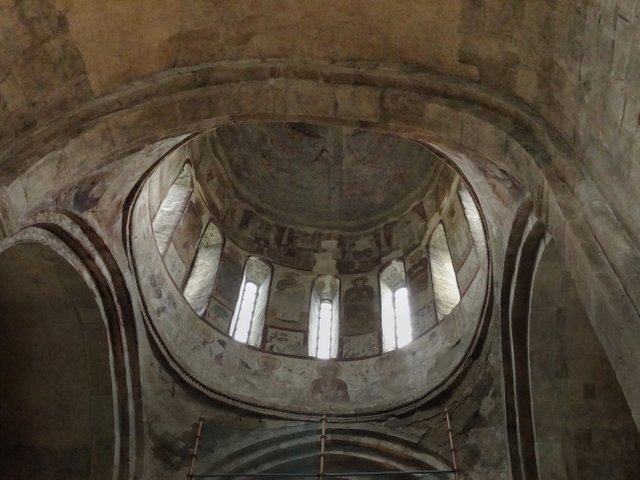
as well as to the rich ornaments at the dome

and the southern façade of the temple.
.jpg)
Don’t forget about the tombs of the Iberian ruler of 4th century, Holy and Equal-to-the-Apostles, king Mirian III, and his wife - Nana.
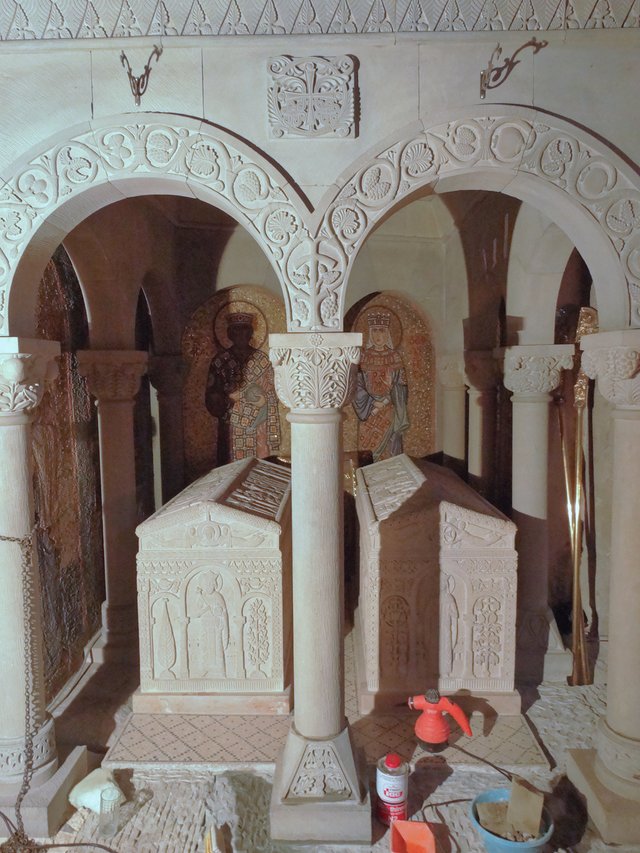
And the chapel of St. Nino:

At least that was, what we’ve managed to see during that visit.
In the background we could see the pictoresque hills
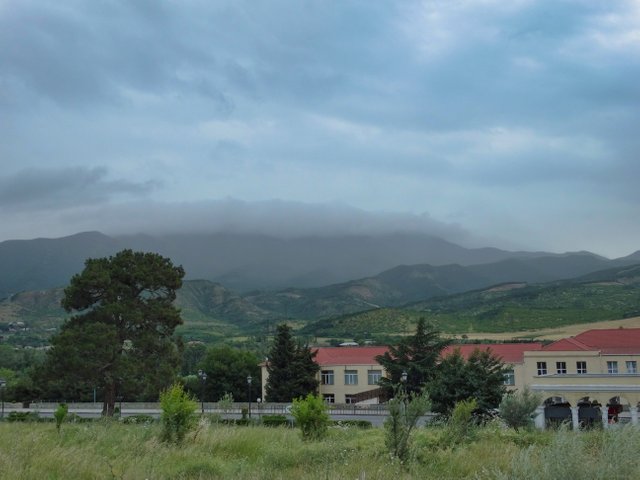
and the Jvari Monastery rising over Mtskheta

After seeing Samtavro, we decided, that while sightseeing is important, it’s already a high time to grab a bite, as we had been feeling hunger more and more. The dinner-and-rest break took us quite a lot of time, and we reached the probably biggest attraction of Mtskheta, the Svetitskhoveli („a living pillar”) Cathedral not earlier than about 7:30 PM. Sure, there was still enough light around, but the conditions for sightseeing were no more great, the more that the large and grey clouds already started to release first drops of water. Anyway - we gazed at the mighty stone walls of 18th century


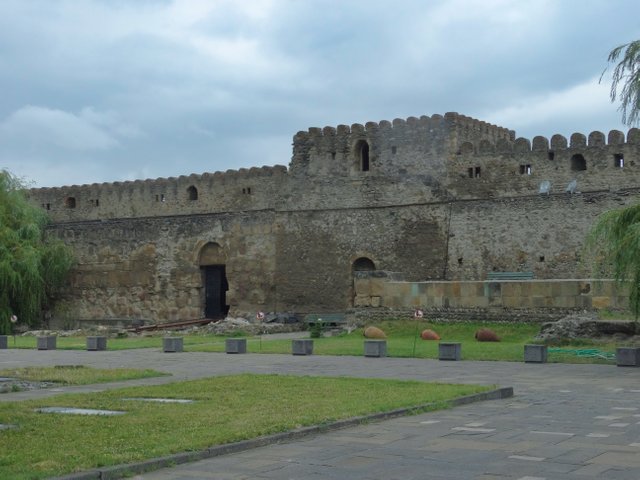


hiding the cathedral of 11th century

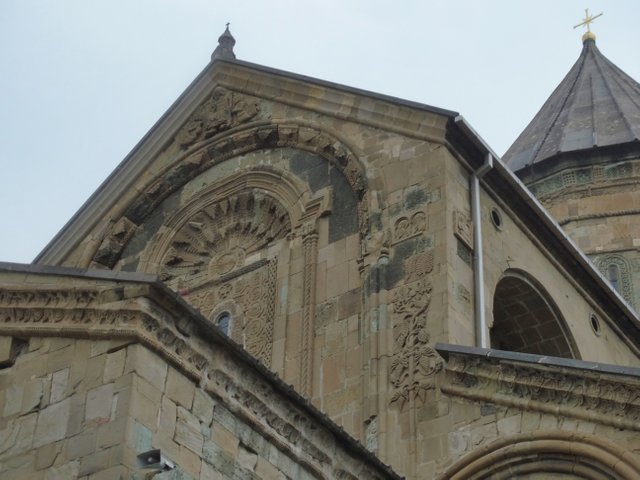
one of the main and most important centers of the Georgian Orthodox Church, a place, where many rulers of this country have been crowned and buried.
The most impressive elements inside were the Jesus Christ Pantocrator fresco

painted over the iconostasis,
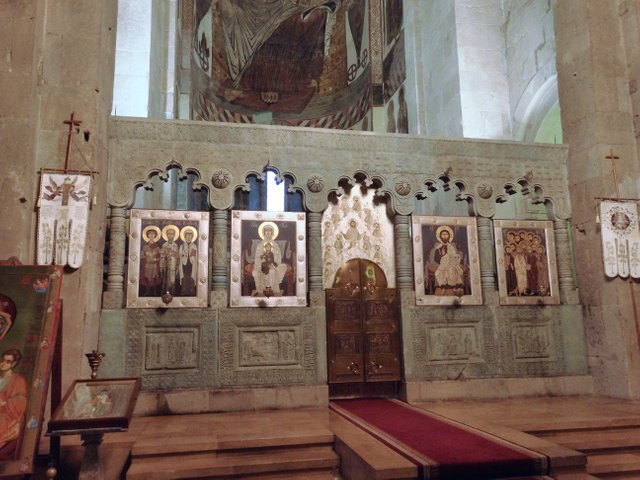
the ciborium from the 17th century (the legend tells, that the robe of the Christ is buried underneath)

and the tombs, being the mute witnesses of the ongoing centuries

(although at that time we weren’t able to find the tomb of the king Vakhtang Gorgasal, the founder of Tbilisi). Unfortunately - the living pillar as well.
Nevertheless it was impossible not to admire the interior of the temple



and its frescos

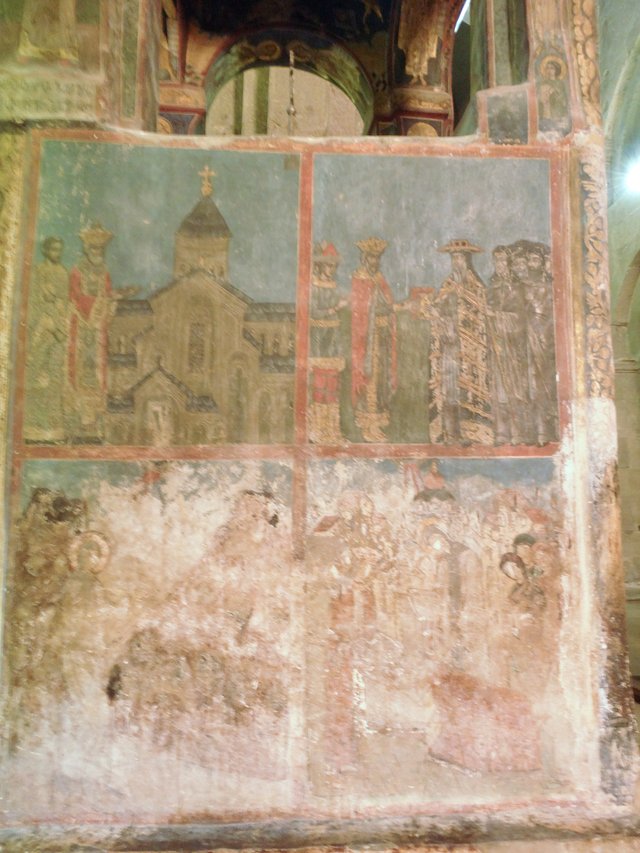
One can find there also the copy of the aedicula of the Church of the Holy Sepulcre, dated for the 14th century:

I have to admit, that we devoted to that place much less, than it deserved - only some half an hour. We omitted also the town itself, as it - on the first sight in the neighbourhood of the cathedral - had rather turistic, not a genuine shape. We really wanted to see also Jvari Monastery on that day, and - as much as possible - avoid driving after the sunset, at least on this first day of our unassisted driving.
The result was rather mediocre. To be sure, Jvari seemed not to be a distant place - in a straight line is just one kilometer further on the opposite bank of the river - but by car, taking into account all the detours and serpentines on the road to the top of the hill, the distance has risen to almost 13 kilometers. At this time we were very happy, that we didn’t have to do that way on foot, the more that it started to rain. Also, the fatigue and stress started to appear - somehow Joanna managed to do some rounds around the town, trying to solve the one-way-streets problem, going against the traffic only once. Luckily nothing more than few hoots happened, but we had to take short break to calm a little - and Joanna wasn’t in a mood to drive to Jvari anymore. But we have tried anyway.
At the top of the hill a small disappointment awaited us. Of course - the monastery itself was beautiful and located in a pictoresque setting.

But at 8:30 PM was already closed for the visitors. All we could do was to look at it from outside



and take a classical photo of the place where rivers Aragvi and Kura unite - a photo spoilt a little by a floodlight enlightening the monastery itself

And then - to do the last kilometers to our headquarters, in rather lousy mood.
As it appeared - reaching Tbilisi was easy. But to get through the 20 kilometers of the Tbilisi evening traffic - already wasn’t, the more that our navigation app had a problem with one-way streets. Instead of parking directly in front of the house, where we were living, we were doing rounds long enough for that after two of them Joanna - frankly speaking being an experienced driver for many years - started crying and stated, that she wasn’t going to drive in that city more, that she didn’t care, where would she park, and so was it. At last, we found the parking place near the Kashueti church.
At that moment, of course, it wasn’t a problem. Some 800 metres of an evening walk after a tiring day is just a pure pleasure. At our quarters a surprise waited for us - the hospitable host has gifted us with a bottle of home wine for a farewell. We tried to invite and convince him to try it together with us, but he eventually refused. Maybe he was an abstinent? Anyway - the content of the bottle appeared to be excellent, and worked perfectly as an anti-stress therapy after such a day.
On the next morning the „true” travel would be waiting for us - and I will take you with us in the next episodes.
TBC